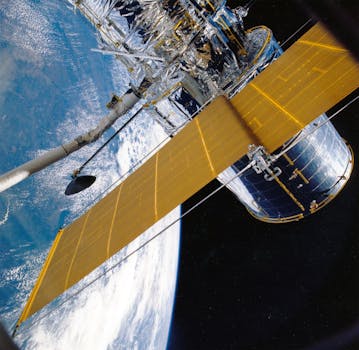
MEO Satellites: Revolutionizing Global Communication with Medium Earth Orbit Technology
MEO satellites, or Medium Earth Orbit satellites, are a type of satellite that operates in an orbit between 2,000 and 36,000 kilometers above the Earth’s surface. This orbit is higher than Low Earth Orbit (LEO) satellites but lower than Geostationary Orbit (GEO) satellites. MEO satellites are designed to provide a range of services, including navigation, communication, and Earth observation.
The use of MEO satellites is becoming increasingly popular due to their unique advantages. One of the main benefits of MEO satellites is their ability to provide global coverage with a smaller number of satellites compared to LEO satellites. This makes them a more cost-effective option for many applications. Additionally, MEO satellites have a longer lifespan than LEO satellites, typically ranging from 10 to 15 years, which reduces the need for frequent replacements.
How MEO Satellites Work
MEO satellites work by transmitting and receiving signals to and from Earth-based stations. They are equipped with transponders, which are devices that receive signals, amplify them, and then re-transmit them back to Earth. MEO satellites are typically used for applications that require a high level of availability and reliability, such as navigation, communication, and weather forecasting.
MEO satellites use a variety of frequencies to transmit and receive signals, including C-band, X-band, and Ka-band. The choice of frequency depends on the specific application and the requirements of the mission. For example, C-band is often used for navigation and communication applications, while X-band is used for Earth observation and weather forecasting.
Applications of MEO Satellites
MEO satellites have a wide range of applications, including navigation, communication, Earth observation, and weather forecasting. One of the most well-known applications of MEO satellites is the Global Positioning System (GPS), which provides location information and timing signals to GPS receivers on the ground.
MEO satellites are also used for communication applications, such as providing internet connectivity to remote or underserved areas. They can be used to provide voice, data, and video services, and are often used in conjunction with other types of satellites, such as GEO satellites, to provide a comprehensive communication network.
Advantages and Challenges of MEO Satellites
MEO satellites have several advantages, including their ability to provide global coverage with a smaller number of satellites, their longer lifespan, and their ability to provide a high level of availability and reliability. However, they also have some challenges, such as the need for more complex systems to manage the satellites and the higher cost of launching and operating them.
Despite these challenges, MEO satellites are becoming increasingly popular due to their unique advantages. As the demand for global communication and navigation services continues to grow, the use of MEO satellites is likely to increase, driving innovation and development in the satellite industry.
Conclusion
In conclusion, MEO satellites are transforming the way we communicate globally, offering faster and more reliable connections. With their unique advantages, including global coverage, longer lifespan, and high availability, MEO satellites are an essential part of the satellite industry. As the industry continues to evolve, we can expect to see even more innovative applications of MEO satellite technology.



